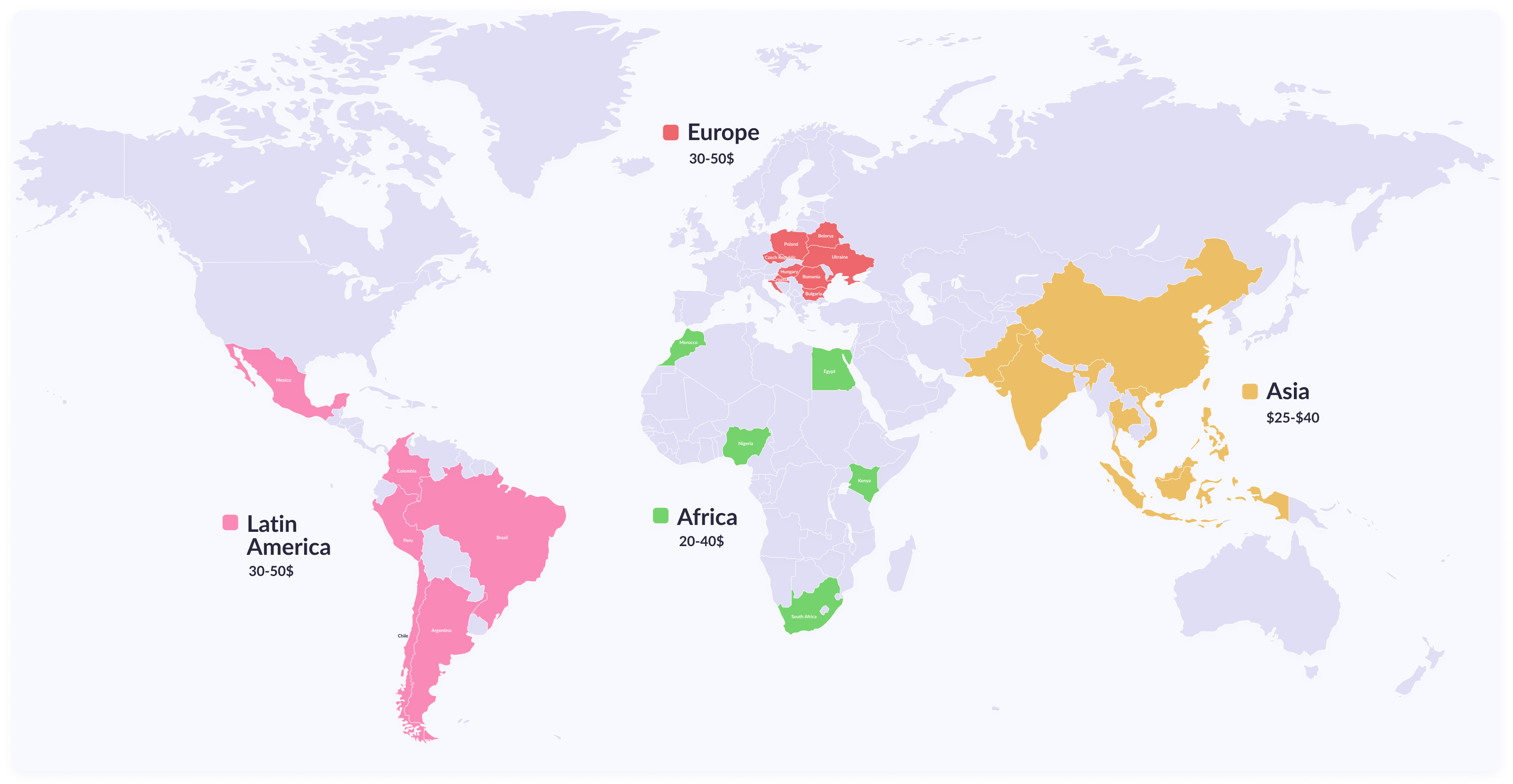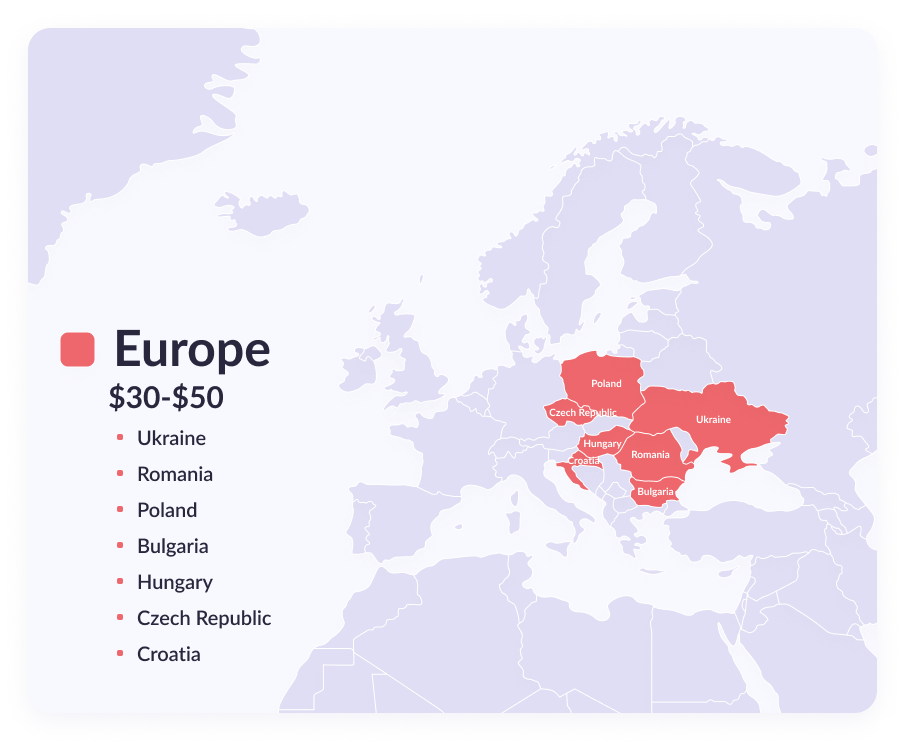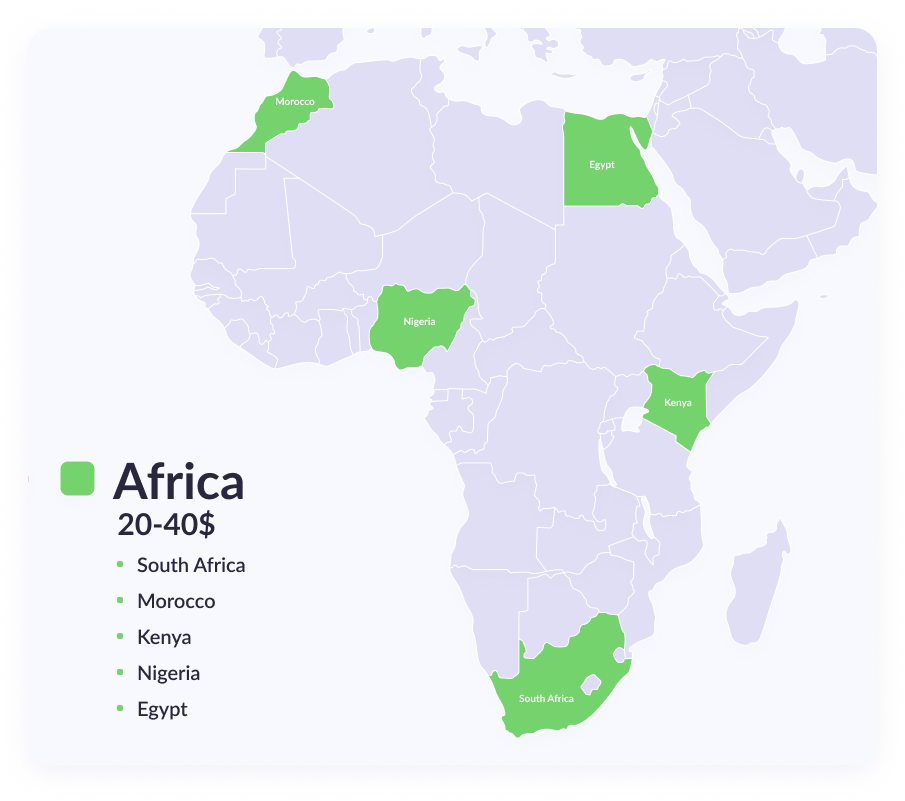Let's harken back to that age-old saying, "You get what you pay for." This saying fits like a glove when it comes to the realm of IT outsourcing.
By hiring outsourcing developers, a company can reduce the cost of developing a web or mobile application by up to 60%, without sacrificing quality. For example, the average software developer contract rate for a senior developer in the USA is about $ 75-$135 per hour, while the same quality developer in Ukraine, for instance, will require $35-$50 per hour.
Market analysis and price comparison are the first things any sensible business person does before choosing an IT outsourcing partner. In this article, we have collected the latest actual global IT outsourcing & outstaffing market figures. As a bonus, we will discuss how to select an IT outsourcing destination and how much it costs to outsource software development.
Why outsource IT services?
Let’s consider the main reasons for using software development services.
#1. Cost savings
One of the primary reasons for selecting outsourcing services is to cut down on business expenses. By leveraging offshore outsourcing services, companies can substantially decrease insurance & labor expenses, and taxes. These cost savings, in turn, enable them to channel resources toward enhancing and expanding their core business. Furthermore, organizations can trim down capital expenditures by avoiding the purchase of hardware and software needed to complete tasks.
#2. Business scaling
Another crucial reason to outsource software development is a company's capacity to swiftly scale its operations without the need to hire additional personnel. This facilitates a rapid response to market changes and an increase in overall profits. For instance, outsourcing the development of a Minimum Viable Product is commonly employed for such purposes.
#3. Increased productivity
Outsourcing empowers companies to promptly adapt to market shifts. When an IT outsourcing company provides services or manufactures goods, it might need to transform itself due to evolving consumer preferences or technological advancements. Outsourcing services allow a company to adeptly respond to such changes, a particularly vital aspect in a fast-paced environment.
#4. Wider range of competencies
A reputable outsourcing provider typically possesses the capability to provide a comprehensive solution for your business. Take Geniusee, for example, which not only offers Minimum Viable Product development services but also excels in AI-powered app development, and technical support, and also provides separate business analysts, project managers, or DevOps services. This versatility proves especially beneficial for software development companies in the early stages of market growth.
#5. High-quality services
An outsourcing company often boasts experience working with diverse clients and comprises a team of professionals equipped with the necessary knowledge and, crucially, experience in your niche to fulfill tasks according to client project requirements. Additionally, outsourcing vendors frequently hold quality certificates, and software licenses, and establish partnerships with leading technology providers.
#6. Reliable level of support and service
Outsourcing web and mobile app development teams commonly implement processes and procedures for project management, quality assurance, and timely customer support. Moreover, they exhibit a higher level of responsibility in fulfilling their commitments to clients.
#7. Transparent terms of cooperation and project control
Outsourcing companies can furnish a detailed work plan, regular reports on completed work, and documentation that proves valuable for future maintenance, ensuring a transparent and controlled collaboration. Moreover, dedicated project managers facilitate clear communication, track project progress, and address potential issues promptly. This structured approach helps both parties maintain alignment on goals, project duration, and expectations.
Is your business technology aligning with your goals?
Maximize your business potential through our custom software development services, developing solutions that drive strategic growth.
Key factors affecting outsourcing costs
The immediate factors influencing outsourcing software development prices to the greatest extent are the volume of the work and project complexity. These indicators determine the required level of qualifications of IT specialists involved in solving the problem, as well as their number.
Additional outsourcing software development costs may also apply. This includes purchasing or leasing the necessary equipment and software. The ratio of expenses for these items depends on many reasons, in particular, on the type of activities carried out.
To a large extent, custom software development outsourcing prices depend on the creativity of the entire project and the level of the task, considered as a function of the planned project scope. When choosing solutions, options for maximum differentiation of IT tasks are preferable. In this case, it is possible to use standard and already proven methods. Serious IT outsourcing companies prefer this algorithm as the most rational and economical. Today this approach is the most common, but this doesn’t mean the exclusion of creativity — heuristic solution methods in reasonable proportions are also necessary.
The software development outsourcing costs are greatly influenced by the competence of the customer themselves, and their ability to correctly formulate and set a task. Ultimately, it is this step that determines the success of all subsequent activities.
The implementation of an optimal information system adapted to the conditions of a specific business requires detailed knowledge of its business processes. Therefore, the terms and software outsourcing costs can be significantly reduced by creating a mixed team of developers from among the in-house team (for example, from North America) and remote team.
Outsourced software development hourly rates comparison by regions

IT outsourcing market rates
Destination | Rates per hour | Countries |
Eastern Europe | $30-$50 | Ukraine, Romania, Poland, Bulgaria, Hungary, Czech Republic, Slovakia, Belarus |
Latin America | $30-$50 | Argentina, Brazil, Mexico, Colombia, Peru, Chile |
Africa | $20-$40 | South Africa, Morocco, Kenya, Nigeria, Egypt |
Asia | $25-$40 | India, China, Indonesia, Philippines, Vietnam, Pakistan, Malaysia, Bangladesh |
Software development outsourcing rates in Eastern Europe

The revenue of the IT outsourcing industry in Central and Eastern Europe is growing 4-5 times faster than the global average: by 20-25% per year versus 5% per year.
Prices for IT outsourcing in Eastern Europe depend on the country. For example, rates for hiring developers in Ukraine will be lower than rates for developers in Poland or the Czech Republic. The average development outsourcing costs are around $30 for a junior software engineer and $50+ for a senior. Below, you can find a table with offshore software development rates by country in Eastern Europe, including outsourcing rates in Ukraine.
The best countries for software development outsourcing are:
Ukraine
Romania
Poland
Bulgaria
Hungary
Czech Republic
Belarus
Croatia
Eastern Europe has all the characteristics of one of the fastest-growing areas in custom software development — from the growth rate of the IT industry to the huge IT talent pool.
Large numbers of technical universities and advantageous business conditions stimulate the industry’s prosperity. Kyiv, Ukraine, is among the fastest-developing cities in the region.
Software development rates by country
Country | Number of specialists | Average rates | Popular technology | Biggest IT cities | Famous startups |
Ukraine | 200K | $30-$50 | React, JavaScript (React, Node, ReactNative), Java, Python, PHP, Swift, AWS | Kyiv, Kharkiv, Lviv, Dnipro, Odessa | |
Romania | 116K | $25-$45 | SQL, Java, JavaScript, Python | București, Cluj-Napoca, Timișoara, Iași | |
Poland | 279K | $40-$55 | Java, SQL, Objective-C, JavaScript, Python, PHP | Warsaw, Kraków, Łódź and Wrocław | |
Bulgaria | 55K | $30-$50 | JavaScript, React, PHP, Java, SQL, Python | Sofia, Plodiv, Burgas, Varna | |
Hungary | 80K | $40-$55 | SQL, Java, Swift, JavaScript (React, ReactNative), Python | Budapest, Miskolc, Debrecen, Pecs, Szekesfehervar | |
Czech Republic | 96K | $35-$55 | JavaScript (ReactNative), Java, SQL, Python, AWS, ReactNative | Prague, Brno, Olomouc, Ostrava | |
Belarus | 54K | $30-$45 | JavaScript, Java, PHP, Python | Minsk, Gomel | |
Croatia | 29K | $25-$50 | SQL, JavaScript, Java, PHP | Zagreb, Split, Dubrovnik |
Pros and cons of cooperation with software engineers from Eastern Europe
Pros | Cons |
Advanced specialized skills at favorable prices | Complex taxation |
Convenient time zones | Increased communication time |
Large talent pool |
|
Location and culture |
|
Laws and regulations |
|
Easy communication. Decent level of English |
|
Fast and cheap broadband Internet |
|
Average outsource software development cost in Asia
Asian countries include some of the top world’s software development outsourcing destinations, and their engineers are famous for their cost-effective solutions, yet not high-quality ones. If you’re thinking about finding a software development partner in Asia, software development rates will reach about $20 for a junior software engineer and $40 for a senior developer in the biggest Asian tech cities.
India and China are the main Asian software development destinations, with nearly 5 million engineers in each country. Indonesia, the Philippines, Vietnam, and Pakistan are also growing markets with the same type of outsourcing services as previous countries. As we mentioned above, the reduction in outsourcing costs and the fast pace of development are achieved at the expense of lower-quality software, especially complex projects. As well as cultural differences, communication barriers, unfavorable working conditions, and differences in time zones negatively affect the quality of communication between the dedicated outsourcing team and the customer.


Thank you for Subscription!
Pros and cons of cooperation with software developers from Asia
Pros | Cons |
Low rates | Low code quality |
A large number of IT specialists | Lack of privacy and data security laws |
| Cultural and communication challenges |
| Unfavorable working conditions |
| Differences in time zones |
| Differences in trends/tastes |
Software offshore development rates in Latin America

Recently, the countries of Latin America have had an increase in demand for software development from customers from the United States due to their relatively close location and the minimum difference in time zones.
Hiring a junior offshore software engineer from a Latin American country like Brazil, Argentina, or Mexico would cost you around $30 per hour, and outsourcing costs of a senior software engineer will vary between $45-$55 per hour. You can also find lower prices like $15-$20 per hour in this region, but mind that the result may not always be of high quality.
Pros and cons of cooperation with software programmers from Latin America
Pros | Cons |
Territorial proximity and convenient time zones | High software outsourcing costs |
Suitable business environment | Hidden costs |
Fast-growing outsourcing market | Limited familiarity with your home country’s laws |
English proficiency | Security risks and information leak |
Cultural compatibility |
|
Average software development hourly rate in Africa

Junior development specialist outsourcing rates in Africa in 2025 are nearly $20 per hour. A limited talent pool of software engineers in African countries leads to higher software development rates compared to other world regions. The outsourcing costs of a senior software developer per hour in such countries as South Africa, Morocco, and Kenya are around $40-$45 per hour on average.
Pros and cons of cooperation with software engineers from Africa
Pros | Cons |
Competitive software outsourcing rates | Low number of IT specialists |
High development speed | Technological stack |
| Lack of privacy and security laws |
| Communication barriers |
IT outsourcing price list in the best regions all over the world
North America | Central Europe | Eastern Europe | South America | Asia | Africa | |
Junior Software Engineer | $55-$80 | $30-50 | $25-$30 | $30-$55 | $20-$30 | $20-$25 |
Middle Software Engineer | $65-$90 | $35-$70 | $30-$40 | $35-$60 | $25-$35 | $25-$30 |
Senior Software Engineer | $75-$125 | $45-$80 | $40-$60 | $45-$65 | $30-$50 | $25-$35 |
Junior UX/UI Designer | $45-$70 | $30-$50 | $20-$30 | $25-$40 | $20-$30 | $20- $25 |
Middle UX/UI Designer | $55-$85 | $35-$65 | $25-$35 | $30-$45 | $20-$35 | $20-$30 |
Senior UX/UI Designer | $65-$100 | $40-$80 | $30-$55 | $35-$65 | $25-$40 | $25-$30 |
Junior Quality Assurance | $60-$80 | $25-$70 | $20-$30 | $35-$45 | $15-$30 | $20-$25 |
Middle QA/QC | $70-$90 | $30-$80 | $25-$40 | $40-$50 | $20-$35 | $25-$30 |
Senior QA/QC | $85-$125 | $40-$80 | $35-$55 | $40-$60 | $20-$45 | $25-$35 |
DevOps | $70-$90 | $55-$70 | $40-$60 | $40-$65 | $20-$40 | $25-$35 |
Software Project Manager | $85-$95 | $50-$70 | $25-$65 | $40-$70 | $30-$50 | $25-$50 |
Business Analyst | $70-$85 | $50-$80 | $30-$65 | $25-$40 | $20-$45 | $25-$35 |
Architect | $110-$125 | $60-$100 | $45-$65 | $45-$75 | $35-$80 | $30-$50 |
How to choose an IT outsourcing destination?
To find the most efficient and reliable outsourcing partner, pay attention to several key factors, such as average rates for IT services, the level of technology industry development, time zone differences, and cultural relevance.
1. Analyze and compare offshore developer rates per hour
The main factor is actually the cost of outsourcing software development reduction. Most entrepreneurs are guided by this when selecting the region to which they plan to transfer the development of their product. Another part of business owners is looking for talent, which is not so easy to find at home. Despite this, you must remember that the success of your software development project is determined by its quality, and as everyone knows, quality requires costs.
The first thing to start with when choosing a region for software development is to analyze and compare the medium rates for IT services.
2. Study the state of the tech industry in different regions
The main indicators for market research are the number of technical universities that developers graduate from, the number of personnel already available on the market, and the popularity of the technology stack needed to develop your project.
If the country you are interested in has an extensive talent pool of IT engineers, a high level of technological education, and occupies a rather large niche in the IT outsourcing market around the world, this means that you are moving in the right direction.
The situation becomes more complicated if your software development project requires a specialist with rare and niche technologies, for example, Scala, Groovy, Q#, Elang, etc.

Some insights for you
The Benefits Of Custom Software Development
Find out how creating customized software can help businesses work better by fitting their unique needs and allowing room for innovation.
Continue reading3. Don't forget the time difference
Interestingly, the belief that the 1-2 hour difference optimally impacts the operational efficiency is often not entirely objective. For example, using the “follow-the-sun” model — a type of global collaboration where problems are resolved around the clock and transferred between offices in different time zones — can increase responsiveness and reduce delays. This approach can also shorten the time to market. Follow-the-sun is used by dedicated development teams that are spread out across the world. The constant workflow increases response time and reduces time to market. This method literally follows the sun, so work is performed during normal work hours anywhere in the world. And customers in one location get the same quality of support as any other location.
However, the 1-2 hour difference is handy when maintaining live communication with remote developers. This hour difference is appropriate if the 2 teams need to plan things together and share knowledge more often.
4. Understand your level of cultural fit
It is believed that cultural compatibility is difficult to measure. But we believe that this is not the case.
This can be easily verified by collecting feedback from small business owners and entrepreneurs who applied for outsourcing services and had experience in cooperation with a particular country.
You can also contact other owners in the destination country and ask all your questions, for example, regarding the legal system, tax collection system, approach to task management, etc.
The issue of cultural compatibility is important as it affects the creation of a comfortable atmosphere during the software development process and the final result of your work.
What are the most popular IT outsourcing pricing models?
When businesses consider outsourcing, one of the most important factors influencing their decision is the pricing model offered by the service providers. World practice has developed 6 main pricing models in this matter. When you’re looking for outsourcing services, you probably will meet the dilemma of choosing one of the available pricing options for software development. Very often, it’s the customer's choice how to cooperate, and it’s quite important for them to understand how to build relationships with the contractor.
Here are some of the common IT outsourcing pricing models, along with ideas and examples.
1. Time and materials (T&M) model. This model is ideal for projects that are not clearly defined in scope and are subject to change. Clients pay for the actual time and resources of the outsourcing partner. For example, a business might use this model for software development, where requirements are expected to change.
2. Fixed price model. Suitable for projects with a clearly defined scope and timeline. The service provider and client agree on a set price for the entire project. A business might use this model to build a company website with predefined features and clear deadlines, or for handling IT audit services.
3. Output-based model. This model ties payment to the achievement of specific, agreed-upon performance metrics. For example, an IT infrastructure maintenance company might be paid based on the percentage of system downtime reduction or the number of successfully resolved incidents over a certain period.
4. Prepaid model. A monthly fee is charged for a predefined set of services. This model is often used for ongoing DevOps tasks such as infrastructure monitoring, deployment automation, and regular system updates. The company pays a fixed amount each month for support and optimization to ensure the stable operation and high availability of its IT services.
5. Shared risk and reward model. Both the client and the service provider share the risks and rewards of the project. For example, if an outsourced project exceeds performance targets, the provider receives a bonus; if it fails to meet requirements, they are subject to a penalty.
6. Cost plus model. The client pays all project costs plus a profit margin. This model is often used in outsourcing, where the client covers the cost of the team, software licenses, and other operational costs, plus an agreed-upon markup. This approach provides flexibility in managing the budget and allows for changes in project requirements or scope.
Each of these models offers different benefits and challenges.
Model | Advantages | Disadvantages | Best for |
1. Time and materials (T&M) | - Flexibility with changing project requirements - Ideal for undefined or evolving projects | - Difficult to estimate total cost upfront - Requires active client involvement | Projects with uncertain scope or evolving requirements, such as software development and R&D projects |
2. Fixed price | - Predictable cost and timeline - Suitable for well-defined projects with clear requirements | - Less flexibility if requirements change - May lead to quality issues if changes arise | Clearly defined, short-term projects, like website development or mobile app development with set features |
3. Output-based | - Payment aligns with performance, incentivizing results - Cost-effective if targets are met | - Requires precise metric definition and tracking - May lead to short-term focus | Projects focused on measurable outcomes, such as IT maintenance, marketing campaigns, or customer support KPIs |
4. Prepaid | - Regular, predictable expenses - Provides long-term service stability and availability | - May lead to unused services if needs fluctuate - Limited flexibility outside agreed scope | Ongoing support, DevOps tasks, or system monitoring requiring consistent service and optimization |
5. Shared risk and reward | - Aligns provider-client interests - Encourages innovation and high performance | - High setup complexity and management - Risk of disagreements on rewards/penalties | High-stakes projects with variable outcomes, like performance optimization or new product development |
6. Cost plus | - Flexibility with changing project costs - Transparent cost tracking | - Risk of uncontrolled costs - Requires client oversight of expenses | Long-term, scalable projects like custom software development or infrastructure expansion with changing requirements |
By carefully considering these pricing structures, businesses can create partnerships that not only reduce costs but also increase value and innovation.
Geniusee can become your long-term IT outsourcing partner
We are an offshore software development company that specializes in hiring software engineers, with a variety of technology stacks, for our clients around the world. You have the opportunity to hire a single developer or a dedicated development team for your project. Each of our developers works directly on your project, which gives a deeper dive into the project’s essence. Since you will manage the project, you will be able to use any outsourcing models and project management tools to track the readiness of tasks and the enterprise software development project as a whole.
Fill out the Contact Us Form if you have any questions.
FAQ
Which country is best for outsourcing?
Ukraine offers a highly-skilled, cost-effective talent pool with strong English proficiency, convenient time zones, and a culture aligned with Western markets.
Brazil is a growing IT outsourcing hub in Latin America, offering skilled developers at competitive prices, strong cultural compatibility with Western markets, and convenient time zones for North American clients.
Poland combines technical expertise, affordable pricing, and alignment with European business standards, making it an ideal choice for companies needing reliable, high-quality services in convenient time zones.
How much does IT outsourcing cost in Ukraine?
The average hourly rate for software outsourcing development in Ukraine ranges from $25 for junior specialists and up to $55 for senior engineers.
What is the average hourly rate for software outsourcing?
The average hourly rate for software outsourcing development ranges from $15-$45 for junior specialists and up to $50-$100 for senior engineers. The price varies greatly depending on the outsourcing region.
How can outsourcing reduce costs?
Software development, which is done in the USA/Western Europe for a very high price, can be obtained at a much lower hourly rate in developing European countries like Ukraine and Poland. The difference in the outsourcing costs varies up to 60%.
Is outsourcing really cheaper?
Yes. You save on wages, taxes, and fees, expenses for employees' workplaces, expenses for software necessary for productive work, and expenses for improving the employees’ qualifications.





















